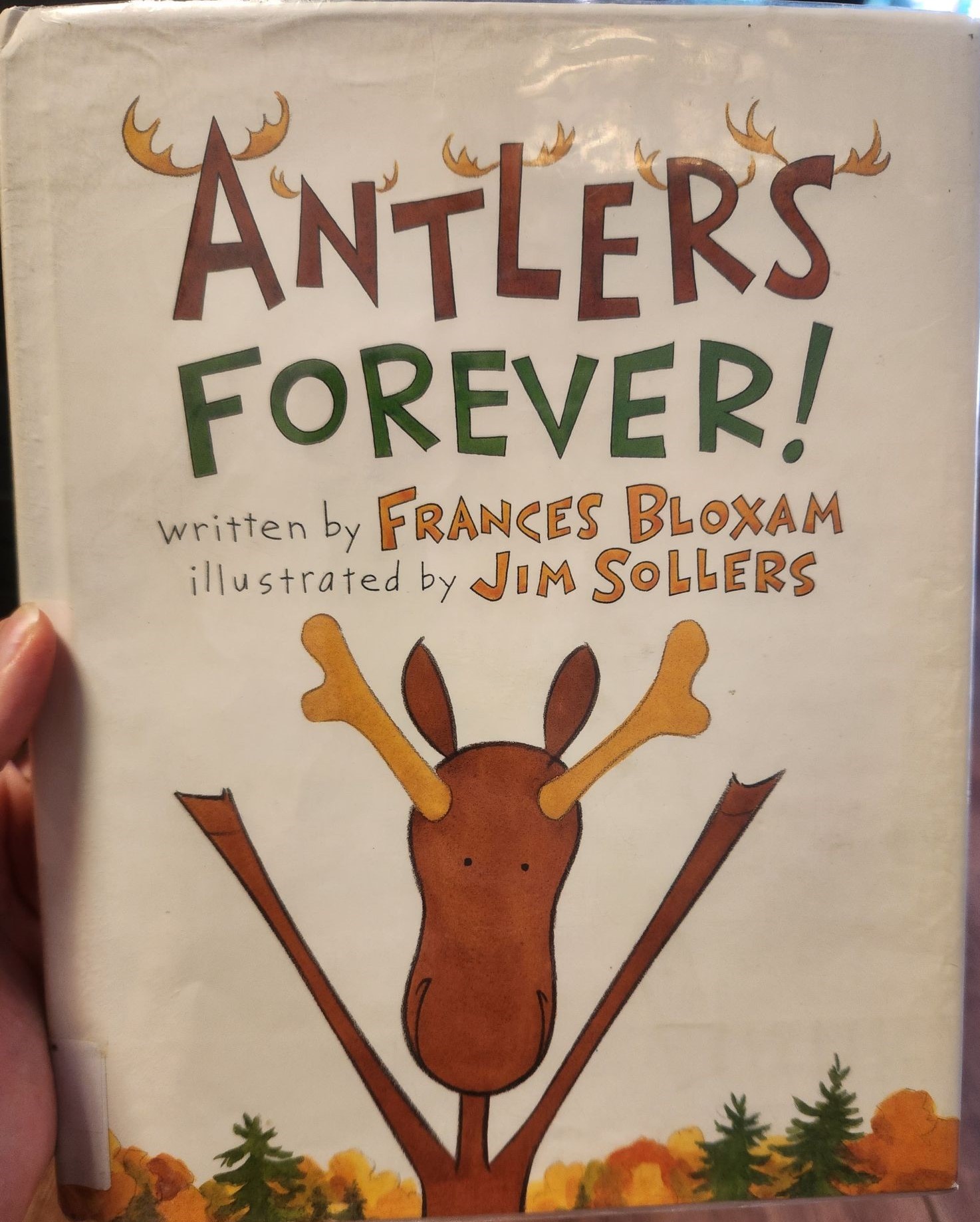This delightful story about a moose losing his antlers for the first time reminds us that loss is a part of life, necessary for new growth. Unsurprisingly, both the author (Frances Bloxom) and illustrator (Jim Sollers) hail from Maine.
“Orville Anderson Tarkington Moose” realizes with horror one morning that his antlers are loose. In hopes of tightening them, Orville snacks on a large quantity of “beezels” to replenish his stock of “Vitamin M”. This, of course, doesn’t work, so he seeks counsel from owl. Owl explains that Orville’s antlers are screwed to his head, so tightening these screws should solve the problem. He holds on to Orville’s antlers while Orville spins, collapsing in a dizzy heap only to find that his antlers have now fallen completely off. He begins to howl so loudly that an older moose from miles away hears him and comes to see what’s the trouble. “Big Moose” explains that losing antlers is a normal part of life for moose. In fact, it is a good thing; come Spring, Orville’s antlers will grow back bigger—and heavier—than before, and the break from this weight is good for Orville’s head. The story concludes, “And that is the story of Orville, the moose, who learned not to fret when his antlers got loose!” The last four pages of the book are devoted to answering some questions readers may have about moose, such as “When do moose get their antlers?” and “What happens to the shed antlers?” and “Does it hurt when they come off?”
Content: 3.5/5
This story is playful, creative, and funny. The blend of fact and fiction sparked questions in me (do moose actually lose their antlers each year?), which the epilogue answered. I also found myself contemplating how the loss of antlers symbolize the loss of other things in life, and how his loss makes way for new life and growth (more on this topic soon!).
Antlers Forever provides an accessible way to talk about loss with a child, whether that looks like baby teeth falling out, a friend moving away, or retiring a beloved binky. One could touch on some of the following thoughts about the necessity of loss (and then waiting) in order for new growth to take place:
Antlers Forever provides an accessible way to talk about loss with a child, whether that looks like baby teeth falling out, a friend moving away, or retiring a beloved binky.
- When we try to hold on to something we’re not meant to hold on to, we waste time and effort that could be spent more productively elsewhere. Orville spends time eating “beezels”, visiting Owl for help, and then engaging in a dizzying attempt to screw his antlers back on—none of which help him achieve his goal, but only result in a hurting belly and a dizzy head—and simply delay (or precipitate!) the inevitable.
- Loss is often necessary to make room for new life. Though it can feel strange or uncomfortable, what comes after the loss is sometimes even better. Big Moose counsels Orville, “It’s clear you don’t know that moose shed their antlers so new ones can grow . . . . And they’ll be much bigger, of that have no doubt.” Of course, “better” is very subjective: “bigger” doesn’t necessarily mean “better”—but perhaps bigger antlers might be a “better fit” for the current season, keeping pace with Orville’s growth.
- Waiting (and rest) is an essential part of the process. As Big Moose explains to Orville, “You must wait till spring, when new antlers will sprout. And they’ll be much bigger, of that have no doubt. They’ll also be heavy, and that’s why it’s best that antlers fall off, so our heads get a rest.” This reminds me of God’s words to the nation of Israel in Isaiah 30:15: “In repentance and rest is your salvation, in quietness and trust is your strength . . .”
- Loss is not the result of failure, and needn’t be a cause for shame—or fear. Orville’s immediate thought is that he has done something wrong and that is why he is losing his antlers. He doesn’t realize what he is experiencing is simply part of the normal rhythm of life and growth. He also fears what others will think when he loses his antlers, not realizing that everyone goes through this process. Finally, Orville learns not to fear the annual dropping of antlers: “And that is the story of Orville, the moose, who learned not to fret when his antlers got loose!”
Contemplating the last few pages with information about how moose actually function in the wild yields the following lessons:
- Growth looks different for different people. Female (cow) moose don’t grow antlers: “they use their energy in other ways”—namely growing, birthing, and protecting baby moose.
- In letting something go, we may help others grow. I thought it was fascinating that after a moose’s antlers drop, forest animals such as rabbits and hedgehogs will nibble on them, gathering important vitamins and minerals from the antlers. The rest will be absorbed into the soil, nourishing it.
- In seasons of difficulty/lack/growth, it is wise to travel lighter, to lose the things we don’t need, the things that aren’t helping us accomplish our goals. By dropping their antlers, moose are able to “travel more quickly and easily” and require less food for nourishment. What can I “lose” in this season? How will that help me “move more quickly and easily”?
Style: 4/5
The text is written in rhyming couplets and fun to read aloud. I appreciate the author’s choice of antiquated/more complex vocabulary like “dreadful” and “fowl.”
Design: 2.5/5
Like the text, the illustrations are entertaining and playful, combining comic and real-life elements. Orville is a cute, round-nosed little moose who, even when worried about losing his antlers, appears to be smiling on each page (though I really think it’s just the curve of his nostrils!).
Overall: 10/15


